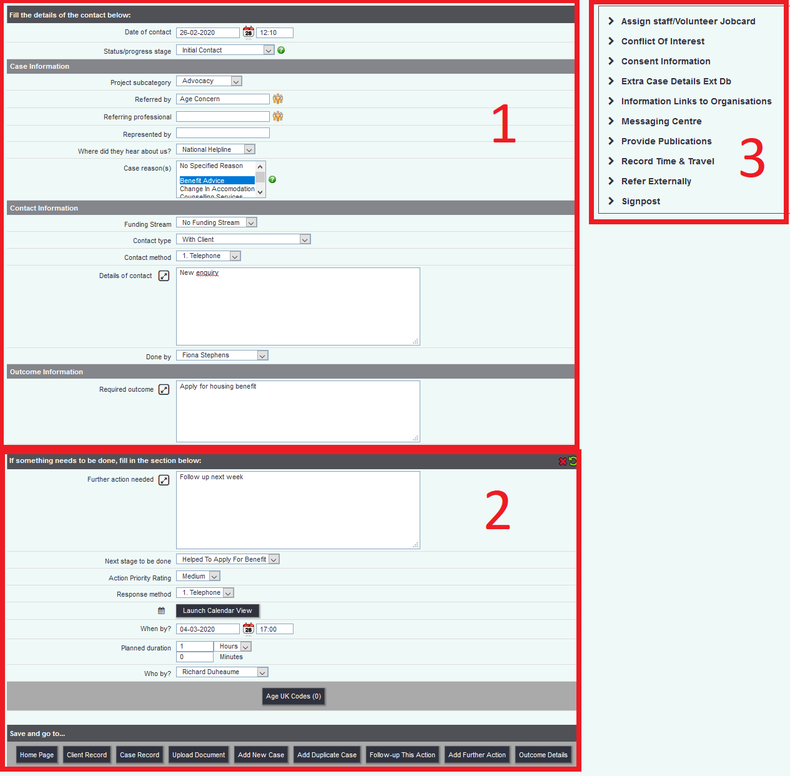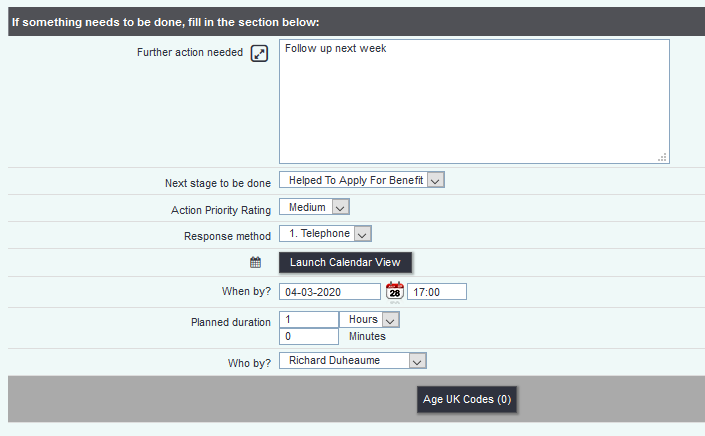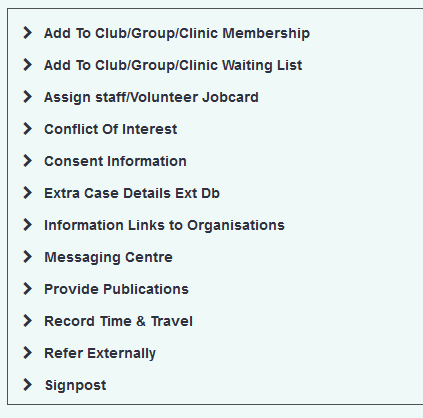Difference between revisions of "Record A Contact"
(→1. The current contact section) |
(→1. The current contact section) |
||
| Line 41: | Line 41: | ||
[[File:RAC_contactdone.PNG]] | [[File:RAC_contactdone.PNG]] | ||
| − | * '''Date of Contact''' - The date that the contact or action was done. If this is the first contact/action for a new referral then this will also be the referral date. This date can be backdated which will affect reports. | + | * '''Date of Contact''' - The date that the contact or action was done. If this is the first contact/action for a new referral then this will also be the referral date. This date can be backdated which will affect reports. The date is mandatory for all systems. |
* '''Status/progress stage''' - This is the Referral Template stage. This field can be prepopulated when using a template on the project selection page or when updating an outstanding action. | * '''Status/progress stage''' - This is the Referral Template stage. This field can be prepopulated when using a template on the project selection page or when updating an outstanding action. | ||
* '''Referred By''' - This first contact will allow the user to record the referrer of the new referral/case. Once recorded it can be changed via the [[Referral Edit]] screen. | * '''Referred By''' - This first contact will allow the user to record the referrer of the new referral/case. Once recorded it can be changed via the [[Referral Edit]] screen. | ||
| + | * '''Referral reason(s)''' - Referral reasons are used to report on why people have come to the service for support, or why they have been referred. This can be a single reason or multiple reasons, see [[Project_Set_Up#Record_a_Contact_tab|Project Set Up]] for details. | ||
| + | * '''Represented By''' - This is a legacy field that is displayed on the initial contact when creating the case/referral. See [[Operational_Rules|Allow entry of "Represented By" (second referrer name) on Record a Contact?]] to enable this option. | ||
| + | * '''Contact With''' - This is a legacy field that is displayed on future contacts, but not the initial contact when creating the case/referral. See [[Operational_Rules|Allow entry of "Contact With" on Actions?]] to enable this option. | ||
| + | |||
| + | |||
| + | |||
For every Contact you will need to enter: | For every Contact you will need to enter: | ||
Revision as of 15:48, 2 January 2019
Contents
[hide]The Record a Contact Screen is one of the most-used parts of the system. Every time a user records a Contact or creates an Action using the Contact Management part of the system, they will use the Record a Contact Screen to do it. Most of the time, new Referrals will also be created using this screen, as the most common way to start a Referral is to record the first Contact for that Referral.
Project and exiting referral selection
If your system has been setup to display existing referrals on the project selection page then you will use the Record A Contact button, if not it will be named 'Create new referral'. When you select the button you will be taken to the project selection:
Each project that is available to you as a user will be displayed, based on the project set up. If Referral Templates have been setup then these will be displayed under the appropriate projects. For projects not using templates or not forced to use template you will be displayed a 'Create Referral' button. Select either a template or new referral button to continue to the Record A Contact page.
If your system has been set to display existing referrals you will see a panel that displays outstanding actions. You can select to update an already existing outstanding action or click 'Show All Referrals' to see existing cases which can then be updated.
Record A Contact Screen
Record a contact is used to manage all aspects of referrals and cases and has the following four modes.
- Creating a new referral/case - This is when the Record A Contact/New Referral button has been selected. This will always display the project selection page.
- Updating an outstanding action Displayed as on Update button on the history tab or Action List which completes the outstanding action and allows future actions if required.
- Adding additional information This is when the Extra Info button on the history page has been selected. It allows for updates to be added that are not related to other outstanding actions and allows future actions if required.
- Creating additional actions to be done - This allows the user to add additional outstanding actions to an existing case/referral via the history tab.
The screen can be broken up into for sections, as numbered in the screenshot below.
- The current contact/action linked information, this is generally what has been done/talked about.
- Further Actions, this creates an outstanding action for the referral/case.
- Options available for the referral/case.
- Save and go to...… specifies what to do after the information is submitted.
1. The current contact section
The top section of the Record a Contact screen uses Project Set Up to tailor what is displayed and which fields are mandatory. The following options are available:
- Date of Contact - The date that the contact or action was done. If this is the first contact/action for a new referral then this will also be the referral date. This date can be backdated which will affect reports. The date is mandatory for all systems.
- Status/progress stage - This is the Referral Template stage. This field can be prepopulated when using a template on the project selection page or when updating an outstanding action.
- Referred By - This first contact will allow the user to record the referrer of the new referral/case. Once recorded it can be changed via the Referral Edit screen.
- Referral reason(s) - Referral reasons are used to report on why people have come to the service for support, or why they have been referred. This can be a single reason or multiple reasons, see Project Set Up for details.
- Represented By - This is a legacy field that is displayed on the initial contact when creating the case/referral. See Allow entry of "Represented By" (second referrer name) on Record a Contact? to enable this option.
- Contact With - This is a legacy field that is displayed on future contacts, but not the initial contact when creating the case/referral. See Allow entry of "Contact With" on Actions? to enable this option.
For every Contact you will need to enter:
- the date of the contact (this will be automatically filled in with today's date, but can be manually changed to any date)
- the details of the contact (some text; this is the narrative that will form the History about the work done)
Where do Contacts go?
Once Contacts are recorded, they are displayed on the History tab (part of the Details Screen for the person that they relate to. This means that all users can go and view details of the Contacts that have happened over time (as long as the user has the relevant access permissions).
They are also saved for reporting. It's easy to produce a report showing how many contacts have been recorded during a time period, how many of those were home visits, how many related to a particular service, and so on.
Optional data on Contacts
The Action section
This is where you can record details of an Action that needs to be done. You do not have to enter an Action - if there is no Action to be done, simply leave the section blank.
Mandatory Data
If you are going to enter an outstanding Action, you will need to enter:
- Further Action needed (this is the description of the Action that will be shown to the person nominated to do it)
- Response Method
- When by? - the date that the Action needs to be done
- Who by? - the person who will do this Action; that user of your system will receive the reminder in their Action List.
Where do Actions go?
Actions, like Contacts, will appear on the History tab for the person they relate to (that is, the client/service user/etc). This means that any user of the system can look at a person's Details Screen and see any work which is outstanding. More importantly, Actions will appear on the Action List of the user that has been nominated to do them. This means that the Action List can replace emails, paper diaries, post-it notes and so on.
Optional Data on Actions
Options section
The Options section contains various headings. Clicking any of the headings in the Options section will pop up a window for you to enter data. The headings that appear in the Options section depend on the way your system is configured, and what other elements exist in the system, but the minimum is likely to be as shown:
- Record Time & Travel
- Signposting and External Referrals
- Assign Staff/Volunteer Jobcard
Extra headings in the Options section
Save and Go To...
All of the buttons at the bottom of the Record a Contact screen will save the data you have entered, but each button will then perform a different action and/or take you to a different place.
- ...Home Page will take you to your Home page - whichever page you see when you first log in.
- ...Record will take you to the Details screen of whichever organisation/person you have been recording work for. For example, if you have been working with/for a Client, you will be returned to their Client Details screen.
- ...Referral Record will take you to the diary view of the Referral.
- ...Upload Document will take you to the Uploaded Documents screen for the org/person you have been working with. The "Relevant Referral No." field will automatically be filled in with the number of the referral you have come from.
- ...Add New Referral will take you back to the Existing/New Referrals screen so that you can enter another referral for the same person.
- ...Add Duplicate Referral will also take you back to the Existing/New Referrals Screen so that you can enter another referral for the same person, but details from the current referral will be copied to the new one (Contact Method, Details of Contact, etc).
- ...Follow-up This Action will let you immediately add a Contact/Action/both to this referral. You will be shown the referral with Extra Info, Further Action and (if appropriate) Update buttons.
- ...Add Further Action will let you add an outstanding Action to this referral - as if you'd clicked the "Further Action" button on the History page.
- ...Outcome Details (or Ladder Outcomes, if you are using them) will take you to the Referral Closure and Outcome Details screen for this Referral.
Rob Kay - manual author (talk) 17:07, 14 August 2017 (BST)




